Multi Tech Systems 92U04A22750 Dual Band CDMA Wireless Modem User Manual
Multi Tech Systems Inc Dual Band CDMA Wireless Modem Users Manual
Users Manual
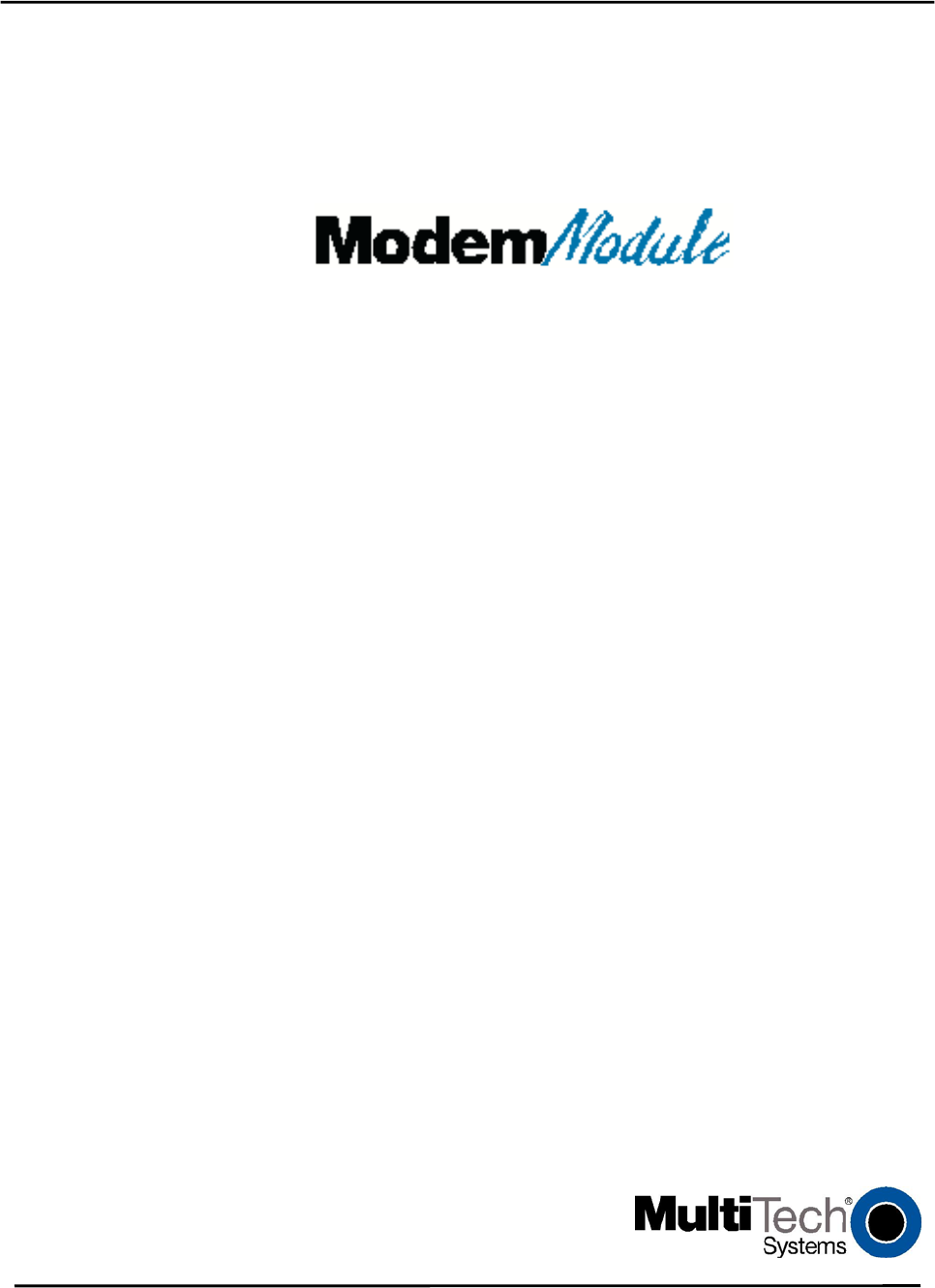
CDMA
Embedded Data/Fax/Voice Wireless Modem
MTMMC-C
Developer’s Guide

Wireless ModemModule MTMMC-C Developer's Guide 2
ModemModule Developer’s Guide
MTMMC-C
PN S000296B, Version B
10/17/03
Copyright
This publication may not be reproduced, in whole or in part, without prior expressed written permission from
Multi-Tech Systems, Inc. All rights reserved.
Copyright © 2003, by Multi-Tech Systems, Inc.
Multi-Tech Systems, Inc. makes no representations or warranties with respect to the contents hereof and
specifically disclaims any implied warranties of merchantability or fitness for any particular purpose. Furthermore,
Multi-Tech Systems, Inc. reserves the right to revise this publication and to make changes from time to time in
the content hereof without obligation of Multi-Tech Systems, Inc. to notify any person or organization of such
revisions or changes.
Revisions
Revision Level Date Description
A7/15/03 Initial release.
B 10/17/03 Update mechanical dimensions drawing.
Patents
This device is covered by patent number 5,673,268.
Trademarks
Trademarks of Multi-Tech Systems, Inc. are ModemModule and the Multi-Tech logo.
MNP and Microcom Network Protocol are registered trademarks of Microcom, Inc.
Microsoft, Windows, and Windows NT are either registered trademarks or trademarks of Microsoft Corporation in
the United States and/or other countries.
World Headquarters
Multi-Tech Systems, Inc.
2205 Woodale Drive
Mounds View, Minnesota 55112
Phone: 763-785-3500 or 800-328-9717
Fax: 763-785-9874
Technical Support
Country By Email By Phone
France: support@multitech.fr (33) 1-64 61 09 81
India: support@multitechindia.com 91 (124) 6340778
U.K.: support@multitech.co.uk (44) 118 959 7774
U.S. and Canada: oemsales@multitech.com (800) 972-2439
Rest of the World: oemsales@multitech.com (763) 717-5863
Internet Address: http://www.multitech.com

Wireless ModemModule MTMMC-C Developer's Guide 3
Table of Contents
CHAPTER 1 – PRODUCT DESCRIPTION AND SPECIFICATIONS ................................................................4
INTRODUCTION ...........................................................................................................................................................4
APPLICATIONS ............................................................................................................................................................4
PRODUCT FEATURES...................................................................................................................................................5
FEATURE DESCRIPTIONS .............................................................................................................................................5
DEVELOPER’S KIT.......................................................................................................................................................6
TECHNICAL SPECIFICATIONS ......................................................................................................................................6
RELATED MANUALS ...................................................................................................................................................6
ADDITIONAL INFORMATION........................................................................................................................................6
CHAPTER 2 – MECHANICAL SPECIFICATIONS..............................................................................................7
MECHANICAL DIMENSIONS.........................................................................................................................................7
CHAPTER 3 – ELECTRICAL CHARACTERISTICS...........................................................................................8
INTRODUCTION ...........................................................................................................................................................8
50-PIN CONNECTOR INTERFACES................................................................................................................................8
50-PIN CONNECTOR INTERFACES (CONTINUED) .........................................................................................................9
POWER CONSUMPTION..............................................................................................................................................11
HANDLING PRECAUTIONS .........................................................................................................................................11
CHAPTER 4 – INTERFACES .................................................................................................................................12
RF INTERFACE ..........................................................................................................................................................12
RF Connector .......................................................................................................................................................12
TRANSMITTER SPECIFICATIONS ................................................................................................................................12
RECEIVER SPECIFICATIONS .......................................................................................................................................13
CHAPTER 5 – TEST BOARD .................................................................................................................................14
TEST BOARD BLOCK DIAGRAM ................................................................................................................................17
CHAPTER 6 – APPLICATION CONSIDERATIONS..........................................................................................18
GENERAL GUIDELINES FOR THE USE OF THE MODEMMODULE.................................................................................18
Hardware and RF.................................................................................................................................................18
The Antenna..........................................................................................................................................................18
Firmware Upgrade...............................................................................................................................................18
Initial Configuration Using Mobile PhoneTools..................................................................................................18
Getting Started .....................................................................................................................................................19
APPENDIX A – SAFETY PRECAUTIONS & REGULATORY STANDARDS COMPLIANCE....................20
SAFETY PRECAUTIONS..............................................................................................................................................20
RF Safety ..............................................................................................................................................................20
General Safety ......................................................................................................................................................21
Safety Standards...................................................................................................................................................22
RF Exposures .......................................................................................................................................................22
Instructions to OEMs............................................................................................................................................22
REGULATORY STANDARDS COMPLIANCE .................................................................................................................22
CDMA compliance ...............................................................................................................................................22
APPENDIX B – SOURCING GUIDE FOR CONNECTORS AND PERIPHERAL DEVICES........................23
CDMA ANTENNA.....................................................................................................................................................23
APPENDIX C – AT COMMAND LIST ..................................................................................................................24
Appendix D – Acronyms and Abbreviations.........................................................................................................29
INDEX ........................................................................................................................................................................30
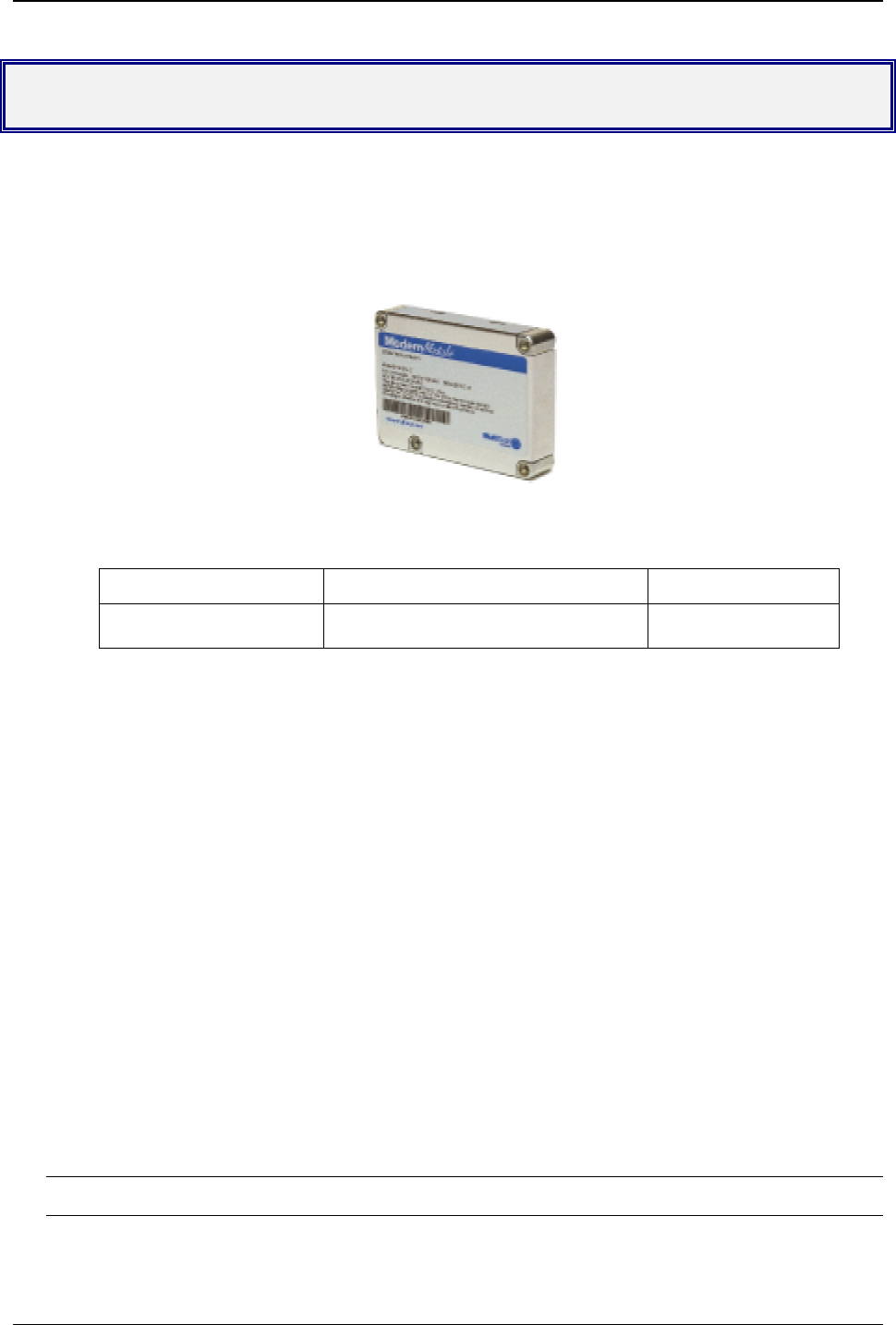
Chapter 1 – Product Description & Specification
Wireless ModemModule MTMMC-C Developer's Guide 4
Chapter 1 – Product Description and Specifications
Introduction
The Multi-Tech ModemModule CDMA is a complete, ready-to-integrate, embedded data/fax/voice wireless
modem packaged in a compact industrial chassis. Designed for global use, it offers standards-based multi-band
CDMA2000 1x performance. This quick-to-market module allows developers to add wireless communication to
products with a minimum of development time and expense. The ModemModule CDMA is based on industry-
standard open interfaces, is fully type approved, and can be board-to-board or board-cable mounted.
Multi-Tech’s Wireless ModemModule CDMA
Product Description Region
MTMMC-C CDMA2000 1xRTT, 800/1900 MHz Global
The MTMMC-C ModemModule is used to integrate wireless data and fax communications in numerous
embedded applications. This product is based on a Dual Band RF Module; every integrated module includes a
CDMA 800/1900 MHz module.
Applications
With packet data speeds up to 153K bps, the ModemModule CDMA is targeted at applications that periodically
need to send and receive data over a wireless network. It is an ideal solution for:
· Appliances
· Remote Diagnostics
· ATM Terminals
· Remote Metering
· Automotive
· Security Systems
· Data Collection
· Vending/Gaming Machines
· Gas Pumps
· Other devices requiring wireless connectivity.
· Industrial and Medical Remote Monitoring Systems
Note: The Wireless ModemModule must be mounted with at least 8 inches (20 cm) of clearance from the
human body.

Chapter 1 – Product Description & Specification
Wireless ModemModule MTMMC-C Developer's Guide 5
Product Features
· CDMA2000 1xRTT operation
· CDMA IS-95-A, IS-95B
· Dual-band 800/1900 CDMA
· Class 2.0 Group 3 FAX
· Board-to-board or board-to-cable mounting
· Short Message Service features including SMS mobile originated, SMS mobile terminated, cell broadcast,
Over the Air Activation (OTA), OTASP, OTAPA
· Voice features include DTMF, telephony, OCELP 13K, echo cancellation
· MMCX antenna connector
· 14.4K circuit-switched data
· Serial interface supports DTE speeds to 230K
· AT command compatible
· Phone book management
· Personal Information Management (PIM)
· Fixed dialing number
· Supplementary services including call forwarding, call barring, multiparty, call waiting and call hold, calling
line identification, closed user group, call transfer
· Real time clock
· Alarm management
Feature Descriptions
Integration Reduces Space, Power and Cost. The ModemModule CDMA integrates the controller, RF
transceiver, and antenna interface in one compact unit. This integration requires low power, low real estate
and provides an overall reduction in costs.
Reduces Development Time. The ModemModule CDMA can make your existing and next generation device,
machine, or system, communication-ready without requiring significant hardware changes to its design. It
actually provides faster time-to-market because it relieves the burden and expense of obtaining network and RF
approvals. This complete, ready-to-integrate wireless module allows you to enhance your product while you
focus on developing its core features.
Voice Features. The ModemModule CDMA provides telephony and Dual Tone Multi Frequency (DTMF)
functionality as well as QCELP (13K) and echo cancellation.
Short Message Services. The ModemModule CDMA offers SMS features such cell broadcast, Over the Air
Activation (OTA), OTASP, and OTAPA. The ModemModule CDMA is SMS Mobile as Originated and SMS
Mobile Terminated.
Compatible Supplementary Services. The ModemModule CDMA is compatible with supplementary services
such as call forwarding, call barring, multiparty, call waiting and call hold, calling line identification, closed user
group and call transfer.
Management Features. The ModemModule CDMA provides advanced management features including phone
book management, fixed dialing number, real-time clock and alarm management.
Industry-standard Modem Commands. The ModemModule CDMA provides industry-standard AT-style
commands for ease of integration into your existing software application.
ModemModule Pin-Out. The ModemModule CDMA interfaces easily with existing products through a standard
serial communication channel. The complete on-board RF transceiver interfaces with an antenna for direct
connection to wireless SMS, circuit-switched dial-up, or packet data networks. The ModemModule is a Data
Terminal Equipment (DTE) device with serial asynchronous protocol support. The serial DTE channel is capable
of transfer speeds to 230K bps and can be interfaced directly to a UART or micro-controller. It can be board-to-
board or board-to-cable mounted.
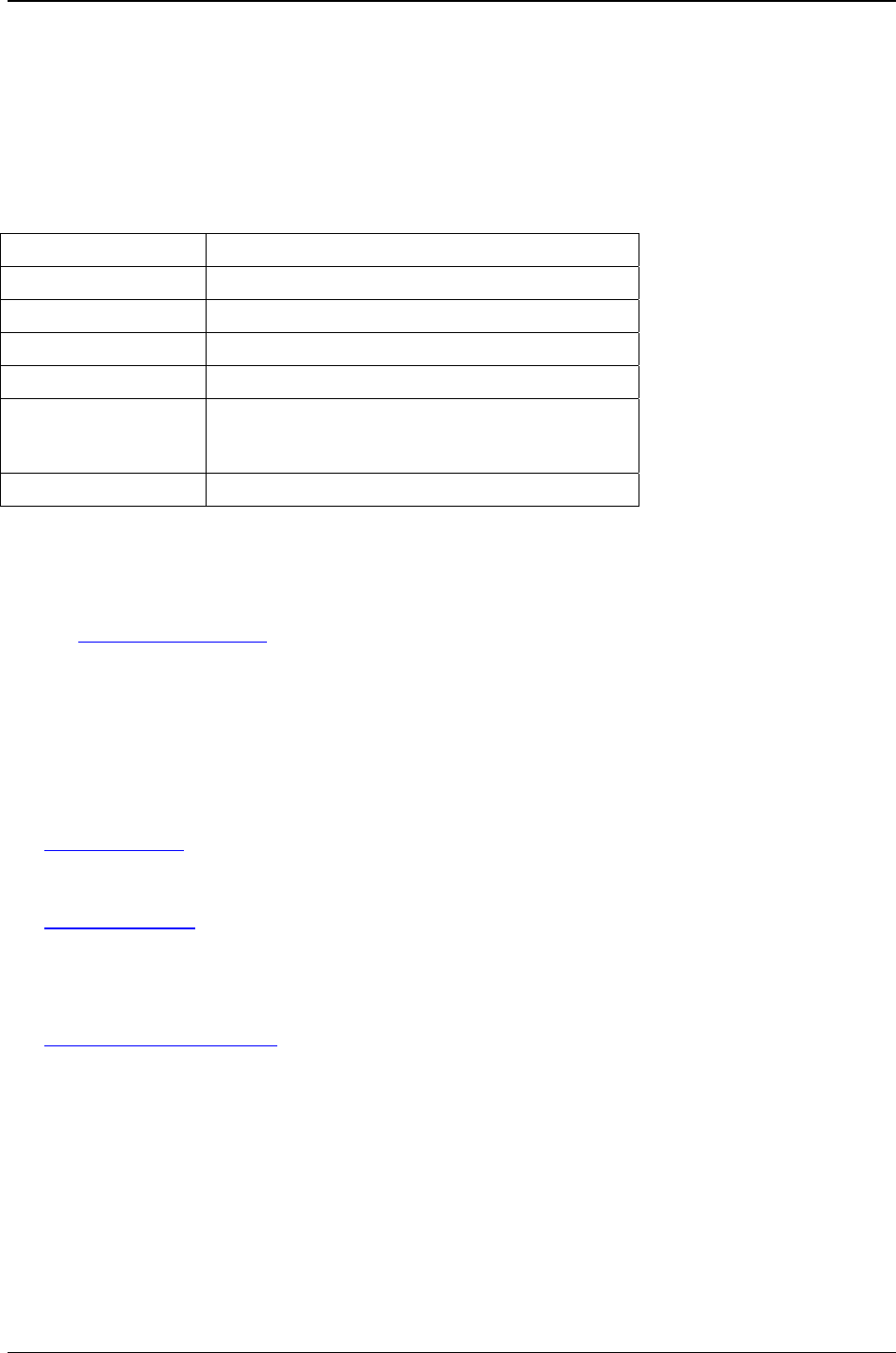
Chapter 1 – Product Description & Specification
Wireless ModemModule MTMMC-C Developer's Guide 6
Developer’s Kit
The ModemModule CDMA Developer’s Kit allows you to plug in the ModemModule and use it for testing,
programming and evaluation. The kit includes one development board with RS-232 DB-25 connector, universal
power supply, antenna and RS-232 cable.
Technical Specifications
Dimensions 2.5" w x 1.8" h x 0.5" d (6.4 cm x 4.6 cm x 1.2 cm)
Weight 88 g
Power Requirements 5 VDC; 400 mA typical, 700 mA maximum
Operating temperature -30°C to + 60°C
Storage temperature -35°C to +85°C
Certifications CD Mark
EMC: FCC Part 2, 15, 22, 24, EN55022 & EN55024
Safety: UL60950, EN60950
Casing Complete shielding-stainless steel/zinc
Related Manuals
At commands for this product are published in a separate document available on the Accessory Kit CD or
from Multi-Tech. Multi-Tech manuals and other resources are available on the Multi-Tech Web page at
http://www.multitech.com.
Additional Information
European Telecommunications Standards Institute (ETSI) - Contact the ETSI at:
650, route des Lucioles
06921 Sophia-Antipolis Cedex
France
Tel: +33 (0)4 92 94 42 00
Fax: +33 (0)4 93 65 47 16
http://www.etsi.org
Global Engineering Documents manages a collection of more than one million documents from over 460
organizations worldwide:
http://global.ihs.com
Phone: 800-854-7179
Fax: 303-792-2192
The ITU is the leading publisher of telecommunication technology, regulatory and standards information, with
over 4,000 titles in printed form, on CD-ROM and Online at
http://www.itu.int/publications/ .
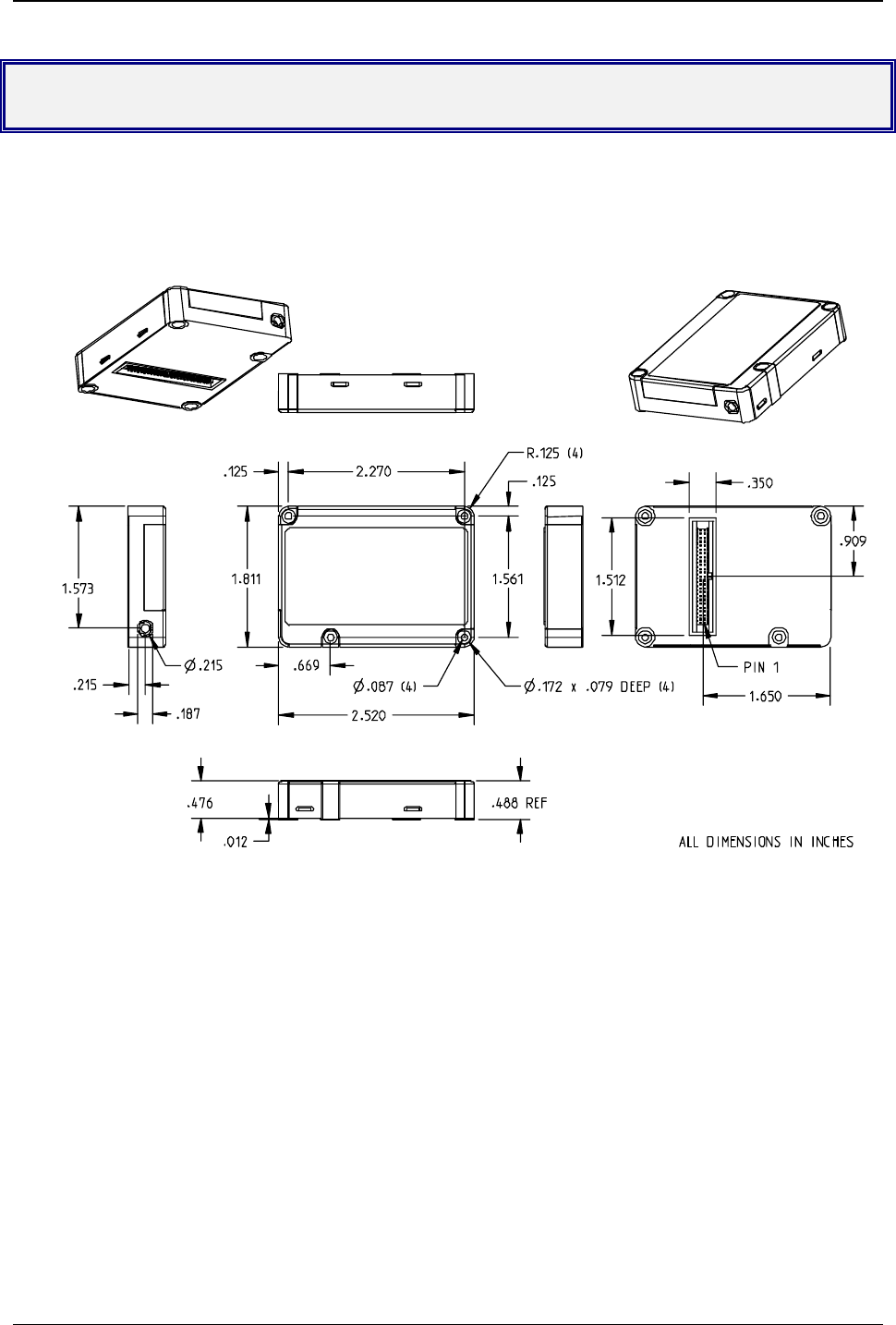
Chapter 2 – Mechanical Specifications
Wireless ModemModule MTMMC-C Developer's Guide 7
Chapter 2 – Mechanical Specifications
Mechanical Dimensions
ModemModule Dimensions
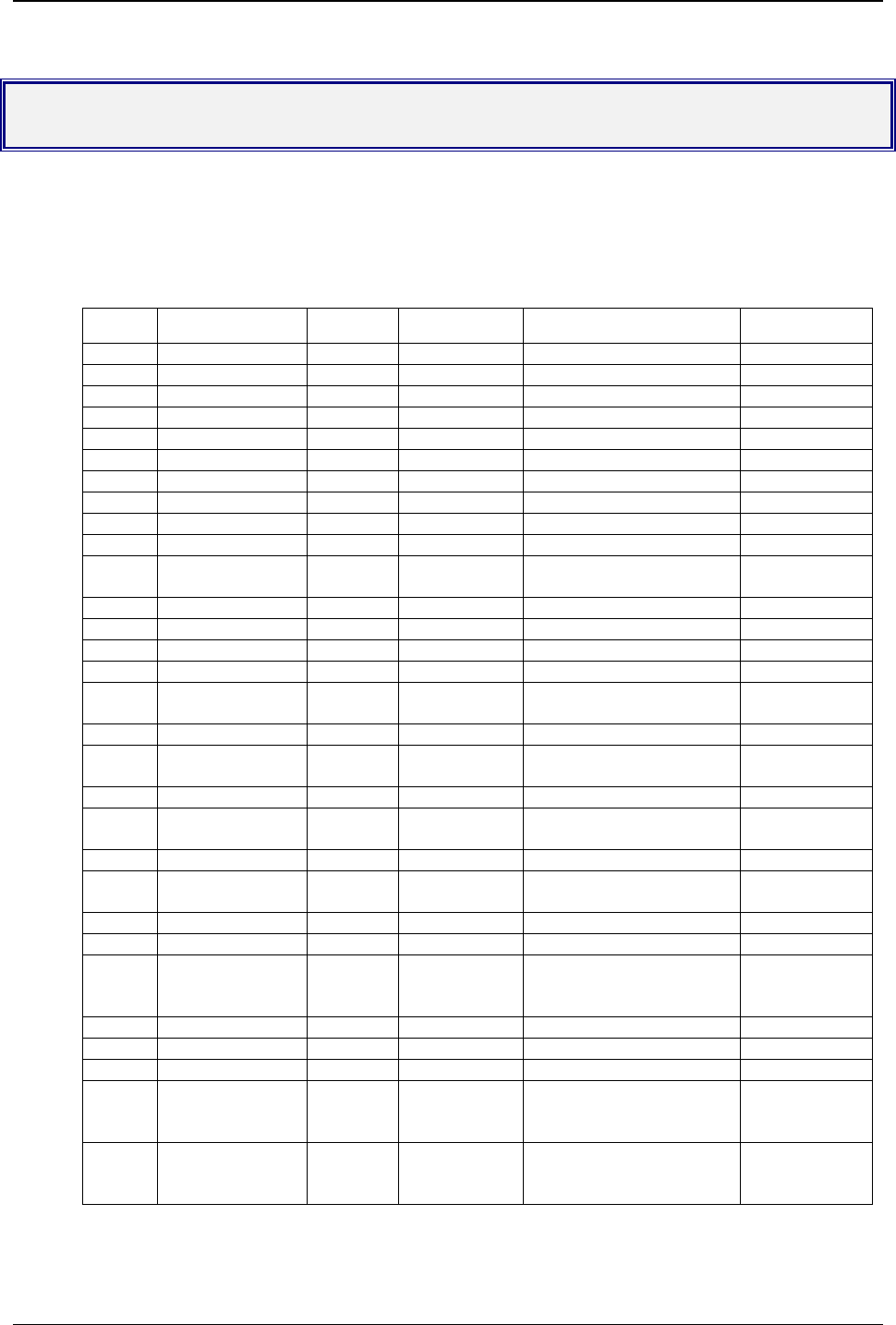
Chapter 3 – Electrical Characteristics
Wireless ModemModule MTMMC-C Developer's Guide 8
Chapter 3 – Electrical Characteristics
Introduction
This chapter describes the ModemModule’s electrical interfaces. These are:
· 50-pin connector (power and data/signaling)
· RF interface
50-Pin Connector Interfaces
Pin # Name I/O I/O Type Description Comment
1GND GROUND High current
2GND GROUND High current
3+5V Supply High current
4+5V Supply High current
5CT109/DCD OCMOS/2X Data Carrier Detect
6GND GROUND High current
7GPI04 I/O CMOS/2X General Purpose I/O
8SPK2N OAnalog Speaker 2 negative output
9CT125/RI OCMOS/2X Ring Indicator
10 SPK2P OAnalog Speaker 2 positive output
11 Flashing LED I/O CMOS/2X Working mode indication
LED
Driven by
module
12 SPK1P OAnalog Speaker 1 positive output
13 CT106/CTS O1X Clear to Send
14 SPK1N OAnalog Speaker 1 negative output
15 ON/~OFF IPower ON/OFF control ON = Vcc
16 MIC2P IAnalog Microphone 2 positive
input
17 AUXV0 IAnalog Auxiliary ADC input
18 MIC2N IAnalog Microphone 2 negative
input
19 ~RST I Reset active low Open Collector
20 MIC1P IAnalog Microphone 1 positive
input
21 GND IGround
22 MIC1N IAnalog Microphone 1 negative
input
23 BOOT IBOOT Open Collector
24 GND GROUND High Current
25 CT103/TX ITransmit Data Pull up with
100K-ohm
when not used
26 GPIO0 I/O CMOS/2X General Purpose I/O
27 CT107/DSR O1X Data Set Ready
28 CT104/RX O1X Receive Data
29 CT108-2/DTR IData Terminal Ready Pull up with
100K-ohm
when not used
30 CT105/RTS IRequest to Send Pull up with
100K-ohm
when not used
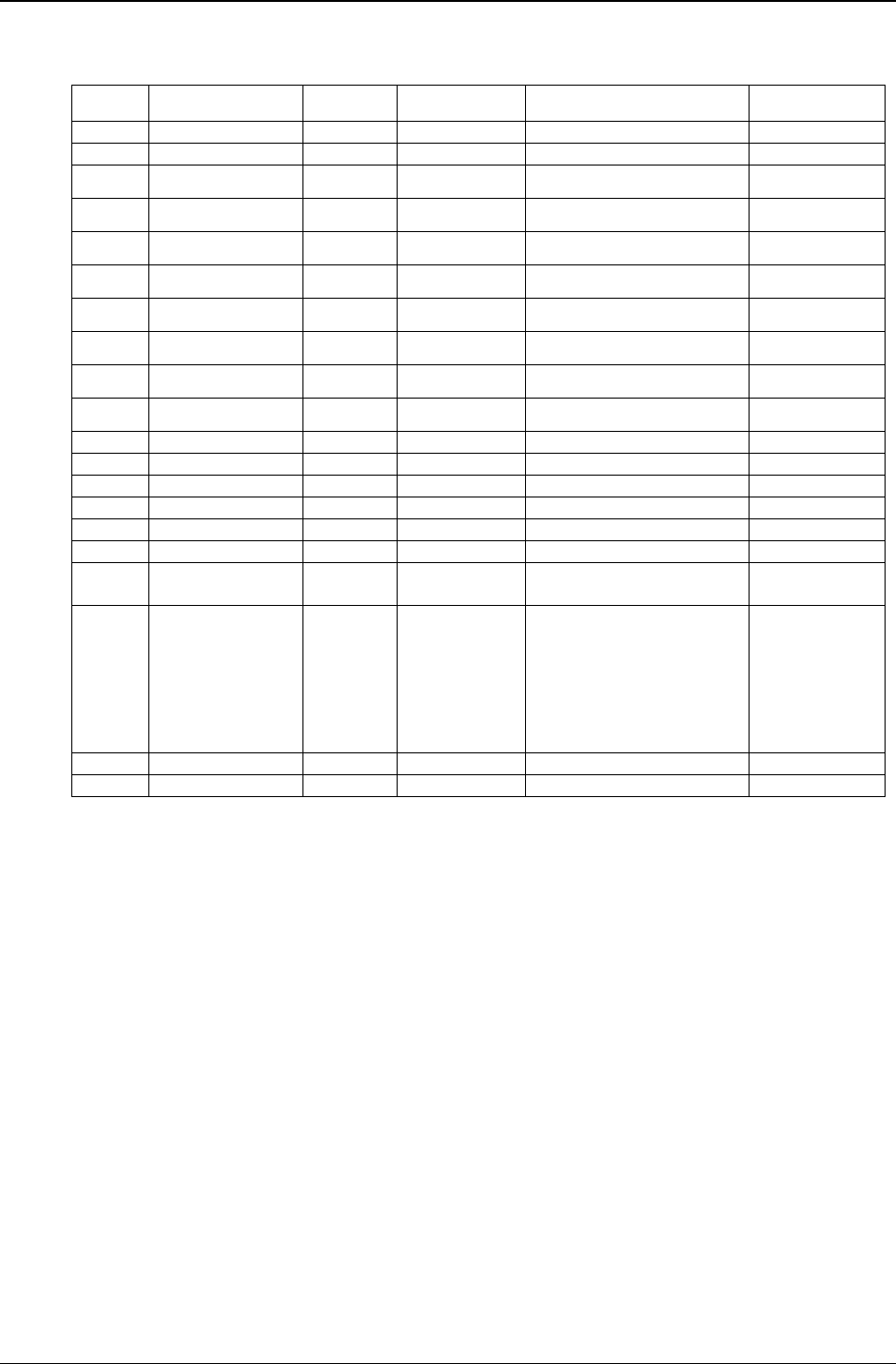
Chapter 3 – Electrical Characteristics
Wireless ModemModule MTMMC-C Developer's Guide 9
50-Pin Connector Interfaces (Continued)
Pin # Name I/O I/O Type Description Comment
31 COL3 I/O 1X Keypad column
32 COL4 I/O 1X Keypad column
33 COL1 I/O 1X Keypad column
34 COL2 I/O 1X Keypad column
35 ROW4 I/O 1X Keypad row
36 COL0 I/O 1X Keypad column
37 ROW2 I/O 1X Keypad row
38 ROW3 I/O 1X Keypad row
39 ROW0 I/O 1X Keypad row
40 ROW1 I/O 1X Keypad row
41 NC Not Connected
42 SPI_EN O1X SPI enable
43 SPI_IO I/O 1X I2C Data or SPI Data
44 SPI_CLK O2X I2C Clock or SPI Clock
45 SIMCLK O2X Clock for SIM interface 3V mode
46 SIMRST O2X Reset for SIM interface 3V mode
47 SIMVCC OSIM card supply 3V mode
6mA max.
48 SIMPRES ISIM card detect Connected to
SIM connector
pin 8. Pin 4 of
SIM connector
must be pulled
down to GND
with 1 K-Ohm*
49 SIMDATA I/O 3X I/O for SIM interface 3V mode
50 GPO0 General purpose I/O
* See SIM socket diagram in SIM interface section
** GPO0 is a general purpose output for selection of external SIM, 3V or 5V.
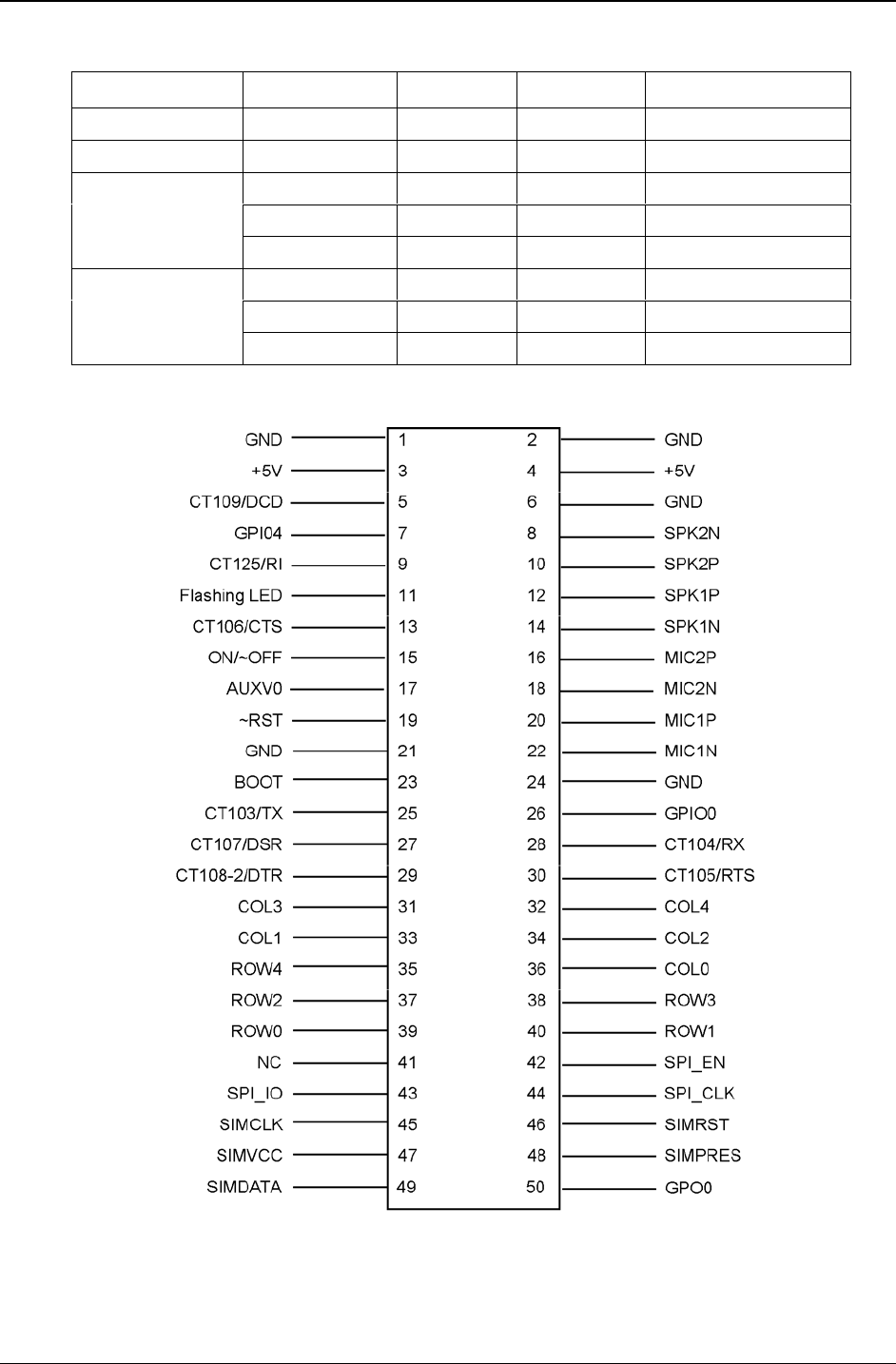
Chapter 3 – Electrical Characteristics
Wireless ModemModule MTMMC-C Developer's Guide 10
Operating Conditions
Parameter I/O Type Min Max Condition
Vinput low CMOS -0.5V 0.8V
Vinput high CMOS 2.1V 3.0V
1X 0.2V IOL = -1mA
2X 0.2V IOL = -2mA
Voutput low
3X 0.2V IOL = -3mA
1X 2.6V IOH = 1mA
2X 2.6V IOH = 2mA
Voutput high
3X 2.6V IOH = 3mA
50-Pin Connector
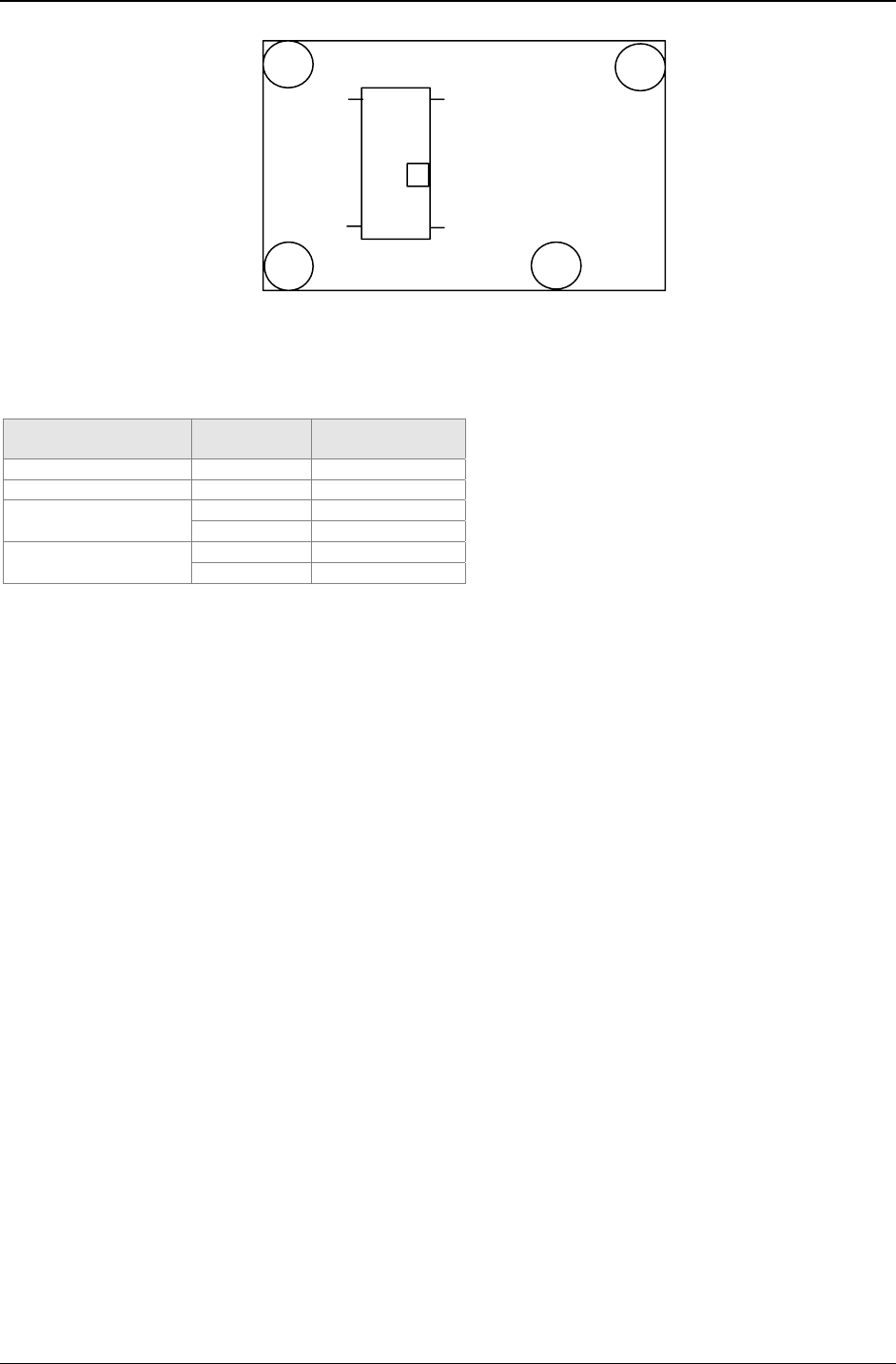
Chapter 3 – Electrical Characteristics
Wireless ModemModule MTMMC-C Developer's Guide 11
50 49
21
Pin Numbering – Bottom View
Power Consumption
Operating Mode Band Average
(mA)
CDMA RXTX Cellular 615
Full Power PCS 770
Cellular 340CMA RXTX
Average Power PCS 445
Cellular 20
CDMA Standby PCS 20
Handling Precautions
All devices must be handled with certain precautions to avoid damage due to the accumulation of static charge.
Although input protection circuitry has been incorporated into the devices to minimize the effect of this static
buildup, proper precautions should be taken to avoid exposure to electrostatic discharge during handling and
mounting.
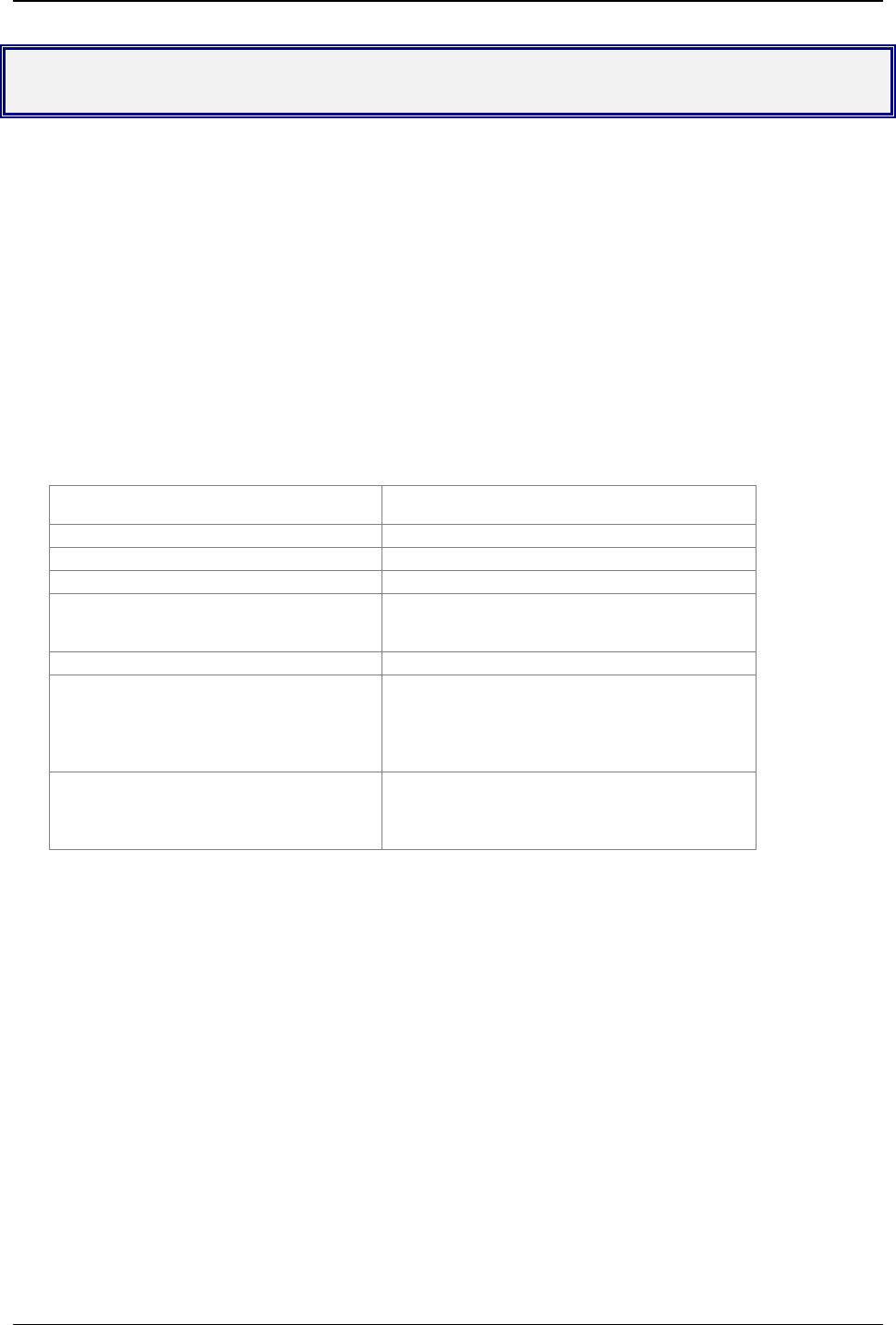
Chapter 4 – Interfaces
Wireless ModemModule MTMMC-C Developer's Guide 12
Chapter 4 – Interfaces
This chapter describes the ModemModule interfaces.
· External antenna
· RF Interface
RF Interface
The impedance is 50 Ohms nominal.
RF Connector
The RF connector is MMCX standard type. An antenna can be directly connected through the mating connector
or using a small adapter.
Transmitter Specifications
Transmitter performance test specification is CDMA2000 mobile station minimum requirement standard, 3GPP2
TSG C0011-A.
Operating Frequency 824MHz ~ 849MHz (Cellular Band)
1850MHz ~ 1910MHz (PCS Band)
Modulation QPSK
Conversion Method Heterodyne
Oscillation Method VCTCXO & PLL Synthesizer
RF Output Power
Maximum
Minimum
0.2W
10nW (-50dBm)
Frequency Stability +/- 300Hz
Open Loop Power Control Output
Power
RX= -25dBm
RX= -65dBm
RX= -104dBm
TX= -57.5 ~ -38.5dBm
TX= -17.5 ~ +1.5dBm
TX= +18 ~ +30dBm
Spurious Emission
RX Band
TX Band
Other Frequency
-80dBm at 1MHz RBW
-61dBm at 1MHz RBW
-47dBm at 30KHz RBW

Chapter 4 – Interfaces
Wireless ModemModule MTMMC-C Developer's Guide 13
Receiver Specifications
Receiver performance test specification is CDMA2000 mobile station minimum requirement standard, 3GPP2
TSG C.S0011-A.
Operating Frequency 869MHz ~ 894MHz (Cellular Band)
1930MHz ~ 1990MHz (PCS Band)
Modulation QPSK
Conversion Method Heterodyne
Oscillation Method VCTCXO & PLL Synthesizer
Receiver Sensitivity -104dBm @ FER 0.5%
Single Tone Desensitization -101dBm @ FER 1%
(FC+/-1900KHz @ -30dBm)
IMD -101dBm @ FER 1%
(FC+/-900KHz, FC+/-1700KHz @ -43dBm)
-90dBm @ FER 1%
(FC+/-900KHz, FC+/-1700KHz @ -36dBm)
-79dBm @ FER 1%
(FC+/-900KHz, FC+/-1700KHz @ -21dBm)
Conducted Spurious Emission
RX Band
TX Band
Other Frequency
-81dBm at 1MHz RBW
-61dBm at 1MHz RBW
-47dBm at 30KHz RBW

Chapter 5 – Test Board
Wireless ModemModule MTMMC-C Developer's Guide 14
Chapter 5 – Test Board

Chapter 5 – Test Board
Wireless ModemModule MTMMC-C Developer's Guide 15
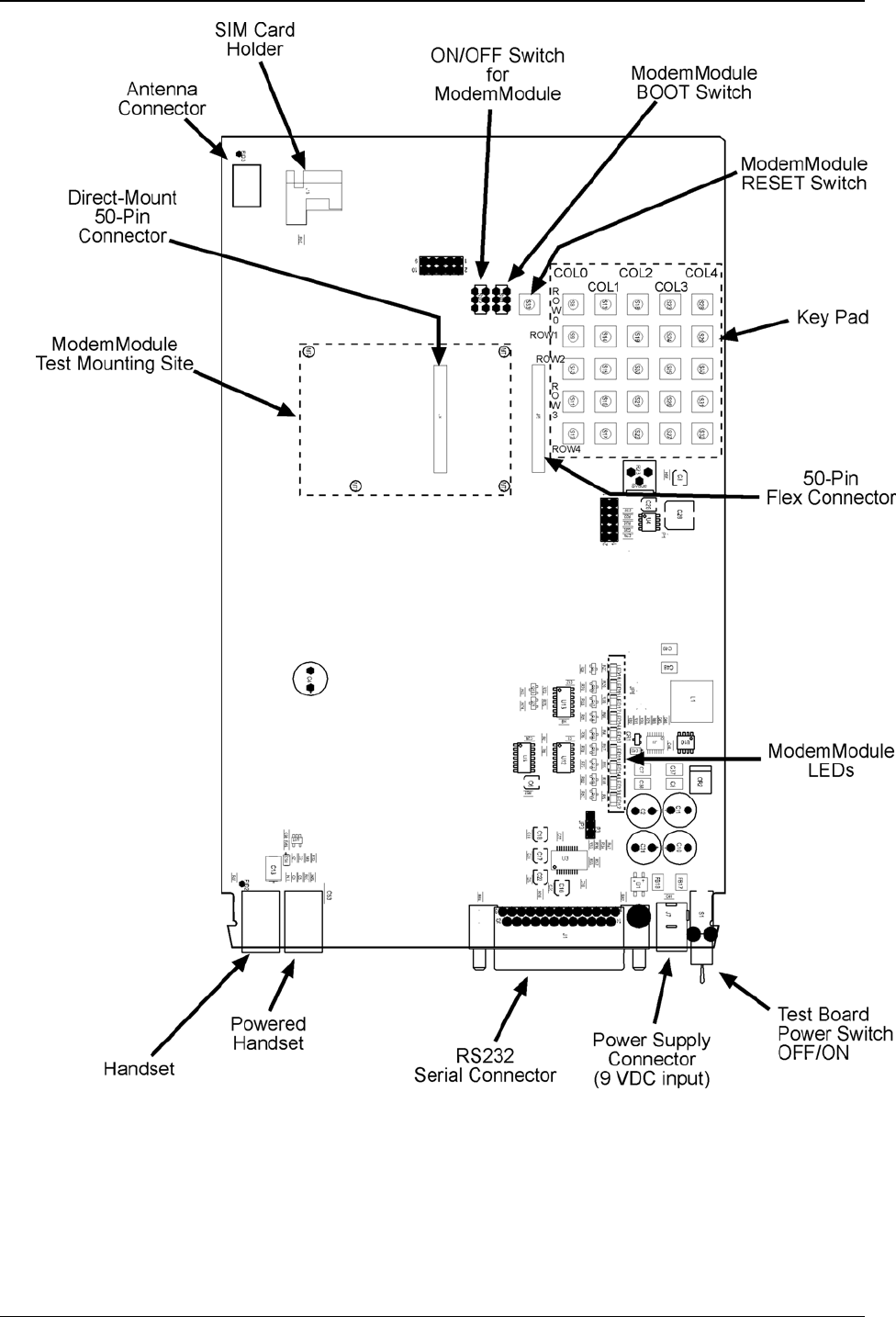
Chapter 5 – Test Board
Wireless ModemModule MTMMC-C Developer's Guide 16
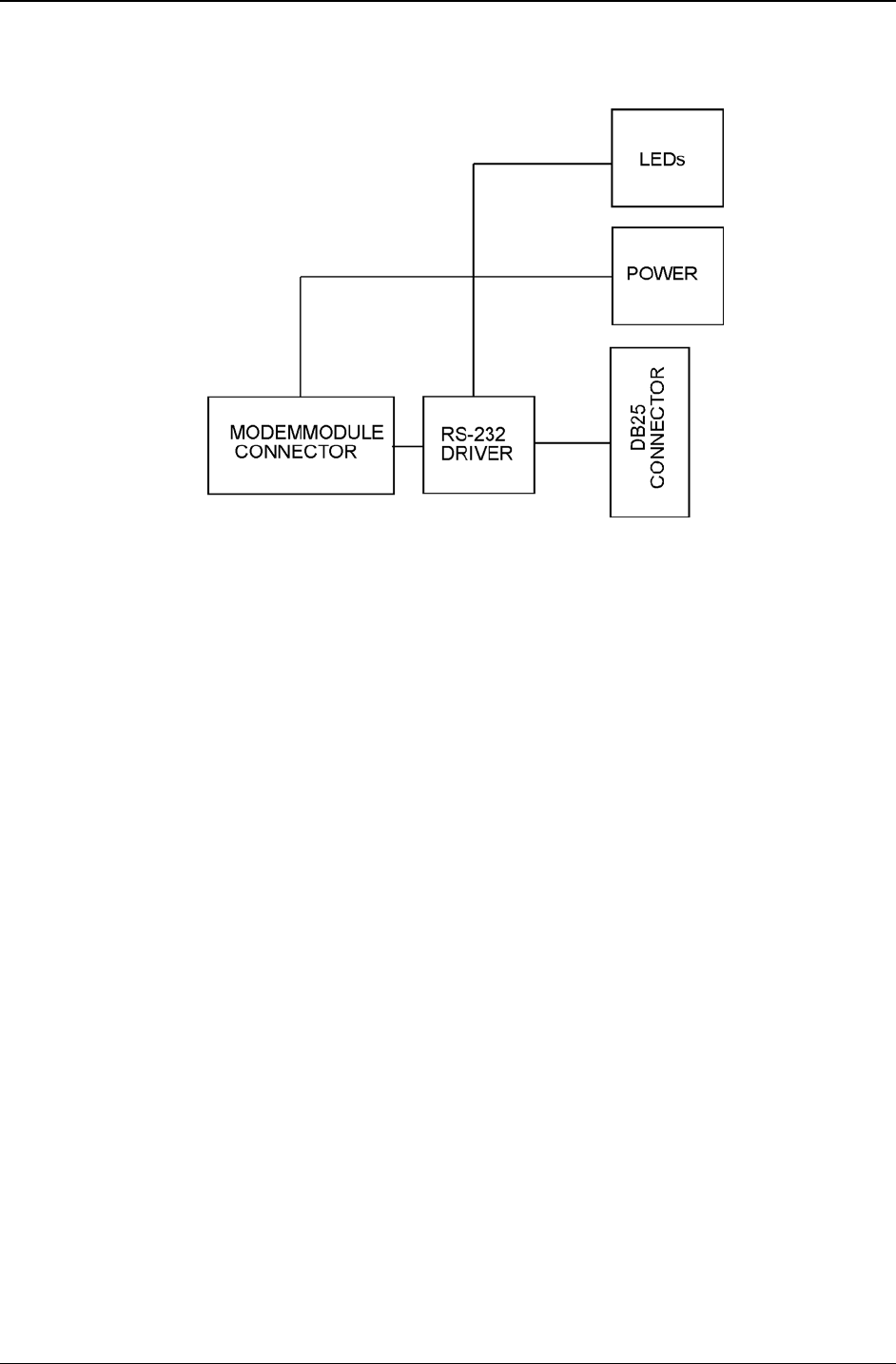
Chapter 5 – Test Board
Wireless ModemModule MTMMC-C Developer's Guide 17
Test Board Block Diagram
Block Diagram

Chapter 6 – Application Considerations
Wireless ModemModule MTMMC-C Developer's Guide 18
Chapter 6 – Application Considerations
General Guidelines for the Use of the ModemModule
Hardware and RF
· Ground plane: Multi-Tech recommends having a common ground plane for analog, digital and RF grounds.
· Bias of the Microphone inputs must be properly adjusted when using audio connectors (mic + speaker) 1.
· EMC protection on audio input/output (filters against 900 MHz)
· ESD protection on serial link
· Possible spurious emission radiated by the application to the RF receiver in the receiver band
The Antenna
The antenna sub-system and integration in the application is a major issue. It is a major issue in the choice of the
antenna cable (type, length, performances, thermal resistance, etc.)
These elements could affect CDMA performances such as sensitivity and emitted power.
The antenna should be isolated as much as possible from the digital circuitry including the interface signals.
Multi-Tech recommends shielding the terminal. On terminals including the antenna, a poor shielding could
dramatically affect the sensitivity of the terminal. Subsequently, the power emitted through the antenna could
affect the application.
Firmware Upgrade
The ModemModule firmware is stored in flash memory, and it can easily be upgraded. Contact the factory for
details.
Initial Configuration Using Mobile PhoneTools
For Initial configuration of your wireless device, Multi-Tech offers a Windows-based mobile PhoneTools
application.
To load Mobile PhoneTools, click on the Mobile PhoneTools icon on the system CD and follow the on-screen
prompts.
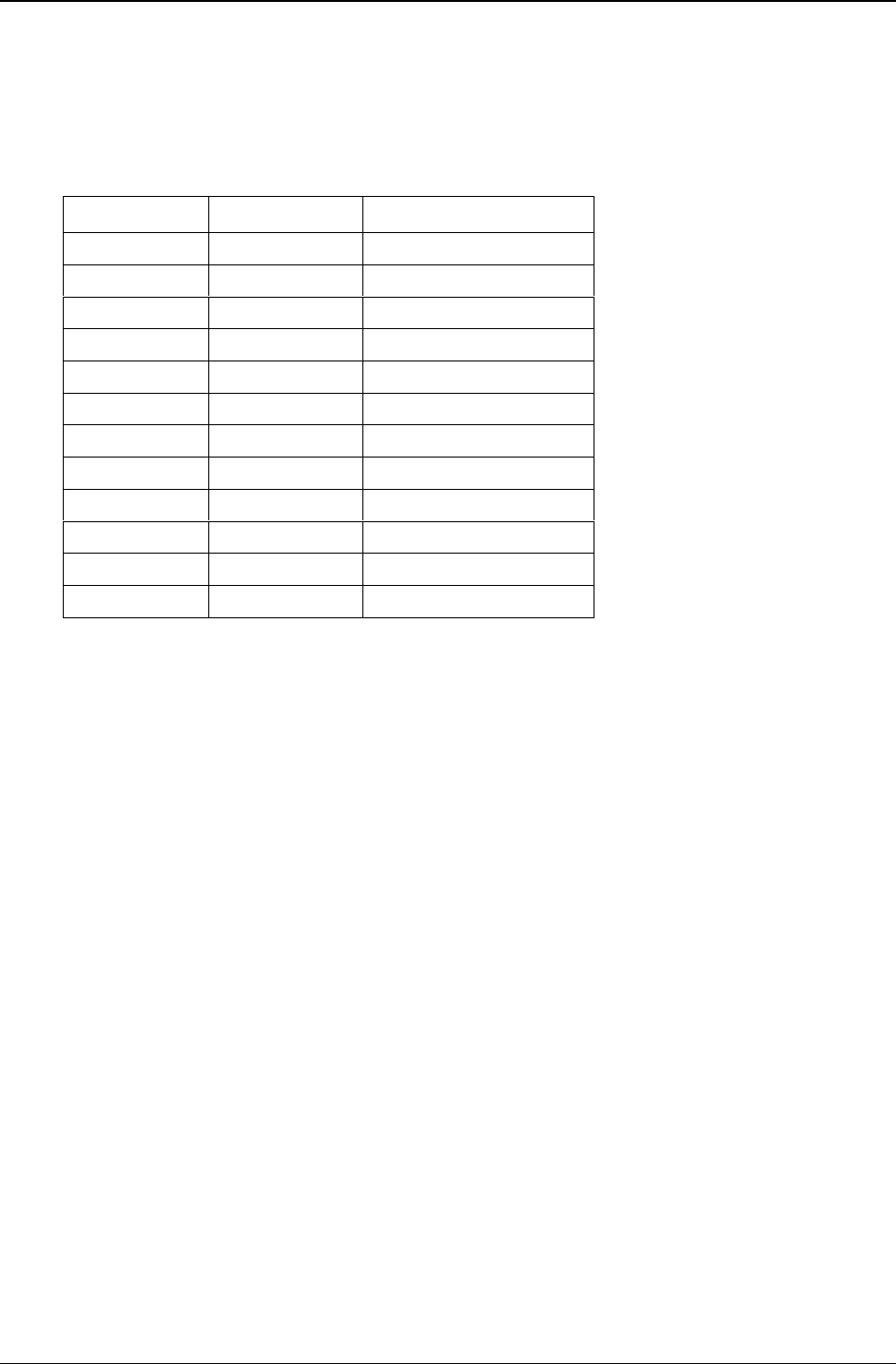
Chapter 6 – Application Considerations
Wireless ModemModule MTMMC-C Developer's Guide 19
Getting Started
Minimum Hardware Interface Required To Get Started
At a minimum, it is necessary to connect the following signals too properly operate the ModemModule:
Pin Number Name Description
1GND Ground
2GND Ground
3+5V Power Supply
4+5V Power Supply
6GND Ground
13 CT106/CTS Clear to Send
15 ON/OFF Power On/Off *
21 GND Ground
24 GND Ground
25 CT103/TX Transmit
28 CT104/RX Receive
30 CT105/RTS Request to Send
* Connected to +5V for example
The serial link signals must be used through the implementation of the serial link level shifter. See “Level Shifter
Application Diagram for Serial Link.”
Terminal Emulator Setup
Here below is an example based on the WindowsTM Hyperterminal application
(terminal emulator program).
Setup:
1. Go to START – PROGRAMS – ACCESSORIES – HYPERTERMINAL.
2. Start the Hyperterminal software.
3. Give the name of your choice, click on the icon of your choice, and click “OK.”
4. Choose these operating parameter values:
Connect using: direct to COM1
Properties: 115200 bps; 8 bits data; no parity; 1 stop bit; hardware flow control.
5. Click “OK.”
Once Hyperterminal is open and configured, it can be used to send AT commands to the ModemModule.
For assistance in testing your ModemModule, see the examples in the AT Command manual for Multi-Tech’s
CDMA wireless modem products (CDMA AT Commands Reference Guide).

Appendix A – Safety Precautions & Regulatory Standards compliance
Wireless ModemModule MTMMC-C Developer's Guide 20
Appendix A – Safety Precautions & Regulatory
Standards Compliance
Safety Precautions
IMPORTANT!
FOR THE EFFICIENT AND SAFE OPERATION
OF YOUR CDMA INTEGRATED MODEM READ
THIS INFORMATION BEFORE USE.
RF Safety
General
Your ModemModule is based on the CDMA standard for cellular technology. Your modem is actually a low
power radio transmitter and receiver. It sends out and receives radio frequency energy. When you use your
ModemModule integrated modem, the cellular system that handles your calls controls both the radio frequency
and the power level of your cellular modem.
Exposure to RF Energy
There has been some public concern about possible health effects of using CDMA modems. Although research
on health effects from RF energy has focused on the current RF technology for many years, scientists have
begun research regarding newer radio technologies, such as CDMA. After existing research had been reviewed,
and after compliance to all applicable safety standards had been tested, it has been concluded that the product
was fitted for use. If you are concerned about exposure to RF energy there are things you can do to minimize
exposure. Obviously, limiting the duration of your calls will reduce your exposure to RF energy. In addition, you
can reduce RF exposure by operating your cellular modem efficiently by following the below guidelines.
Efficient Modem Operation
For your modem to operate at the lowest power level, consistent with satisfactory call quality:
· If your modem has an extendible antenna, extend it fully. Some models allow you to place a call with
the antenna retracted. However your modem operates more efficiently with the antenna fully extended.
· Do not hold the antenna when the modem is « IN USE ». Holding the antenna affects call quality and
may cause the modem to operate at a higher power level than needed.
Antenna Care and Replacement
Do not use the modem with a damaged antenna. If a damaged antenna comes into contact with the skin, a minor
burn may result. Replace a damaged antenna immediately. Consult your manual to see if you may change the
antenna yourself. If so, use only a manufacturer-approved antenna. Otherwise, have your antenna repaired by a
qualified technician. Use only the supplied or approved antenna. Unauthorized antennas, modifications or
attachments could damage the modem and may contravene local RF emission regulations or invalidate type
approval.

Appendix A – Safety Precautions & Regulatory Standards compliance
Wireless ModemModule MTMMC-C Developer's Guide 21
General Safety
Driving
Check the laws and the regulations regarding the use of cellular devices in the area where you have to drive as
you always have to comply with them. When using your modem while driving, please: give full attention to
driving, pull off the road and park before making or answering a call if driving conditions so require.
Electronic Devices
Most electronic equipment, for example in hospitals and motor vehicles is shielded from RF energy. However RF
energy may affect some improperly shielded electronic equipment.
Vehicle Electronic Equipment
Check your vehicle manufacturer representative to determine if any on-board electronic equipment is adequately
shielded from RF energy.
Medical Electronic Equipment
Consult the manufacturer of any personal medical devices (such as pacemakers, hearing aids, etc...) to
determine if they are adequately shielded from external RF energy. Turn your modem OFF in health care
facilities when any regulations posted in the area instruct you to do so. Hospitals or health care facilities may be
using RF monitoring equipment.
Aircraft
Turn your modem OFF before boarding any aircraft.
· Use it on the ground only with crew permission.
· Do not use it in the air.
To prevent possible interference with aircraft systems, Federal Aviation Administration (FAA) regulations require
you to have permission from a crewmember to use your modem while the aircraft is on the ground. To prevent
interference with cellular systems, local RF regulations prohibit using your modem while airborne.
Children
Do not allow children to play with your modem. It is not a toy. Children could hurt themselves or others (by
poking themselves or others in the eye with the antenna, for example). Children could damage the modem, or
make calls that increase your modem bills.
Blasting Areas
To avoid interfering with blasting operations, turn your unit OFF when in a « blasting area » or in areas posted: «
turn off two-way radio ». Construction crews often use remote control RF devices to set off explosives.
Potentially Explosive Atmospheres
Turn your modem OFF when in any area with a potentially explosive atmosphere. It is rare, but your modem or
its accessories could generate sparks. Sparks in such areas could cause an explosion or fire resulting in bodily
injuries or even death. Areas with a potentially explosive atmosphere are often, but not always, clearly marked.
They include fueling areas such as petrol stations; below decks on boats; fuel or chemical transfer or storage
facilities; and areas where the air contains chemicals or particles, such as grain, dust, or metal powders. Do not
transport or store flammable gas, liquid, or explosives, in the compartment of your vehicle that contains your
modem or accessories. Before using your modem in a vehicle powered by liquefied petroleum gas (such as
propane or butane) ensure that the vehicle complies with the relevant fire and safety regulations of the country in
which the vehicle is to be used.

Appendix A – Safety Precautions & Regulatory Standards compliance
Wireless ModemModule MTMMC-C Developer's Guide 22
Safety Standards
THIS WIRELESS MODEMMODULE COMPLIES WITH ALL APPLICABLE RF SAFETY STANDARDS. This
cellular modem meets the standards and recommendations for the protection of public exposure to RF
electromagnetic energy established by governmental bodies and other qualified organizations, such as the
following:
· Directives of the European Community,
· Directorate General V in Matters of Radio Frequency Electromagnetic Energy
RF Exposures
Pursuant to 47 CFR § 24.52 of the FCC Rules and Regulations, personal communications services (PCS)
equipment is subject to the radio frequency radiation exposure requirements specified in § 1.1307(b), § 2.1091
and § 2.1093 as appropriate.
The Multi-Tech ModemModule is a CDMA (PCS 1900) terminal which operates in the US licensed PCS
frequency spectrum. The device transmits over the 1850-1910 MHz band and receives over the 1930-1990 MHz
Band. Mult-Tech Systems, Inc. certifies that it has determined that the Modem complies with the RF hazard
requirements applicable to broadband PCS equipment operating under the authority of 47 CFR Part 24, Subpart
E of the FCC Rules and Regulations. This determination is dependent upon installation, operation and use of the
equipment in accordance with all instructions provided.
The Modem is designed for and intends to be used in fixed and mobile applications. "Fixed" means that the
device is physically secured at one location and is not able to be easily moved to another location. "Mobile"
means that the device is designed to be used in other than fixed locations and generally in such a way that a
separation distance of at least 20cm is normally maintained between the transmitter's antenna and the body of
the user or nearby persons. The Modem is not designed for or intends to be used in portable applications (within
20 cm of the body of the user) and such uses are strictly prohibited. To ensure that the unit complies with current
FCC regulations limiting both maximum RF output power and human exposure to radio frequency radiation, a
separation distance of at least 20cm must be maintained between the unit's antenna and the body of the user
and any nearby persons at all times and in all applications and uses.
Finally, the tune-up procedure for the O9EM2113 ensures that the maximum RF output power of
the device does not exceed 30.0 dBm within the variations that can be expected due to quantity production and
testing on a statistical basis.
Instructions to OEMs
The Multi-Tech product manual includes specific warnings and cautions in order to ensure that OEMs are aware
of their responsibilities, with regards to RF exposure compliance, for products into which the modem is
integrated. With this guidance, the OEM will be able to incorporate into their documentation the necessary
operating conditions and warnings.
OEMs need to provide a manual with the ‘’final’’ product that clearly states the operating requirements and
conditions and that these must be observed to ensure compliance with current FCC RF exposure requirements /
MPE limits (see the “RF Exposures” section above). This will enable the OEM to generate (and provide the end-
user with) the appropriate operating instructions, warnings and cautions, and/or markings for their product.
Regulatory Standards Compliance
CDMA compliance
The ModemModule is in compliance with reference regulations: TBR 19, TBR 20, TBR 31, TBR 32.
CE Label
The Wireless ModemModule is CE compliant, which implies that the modem is in conformity with the European
Community directives and it bears the CE label.
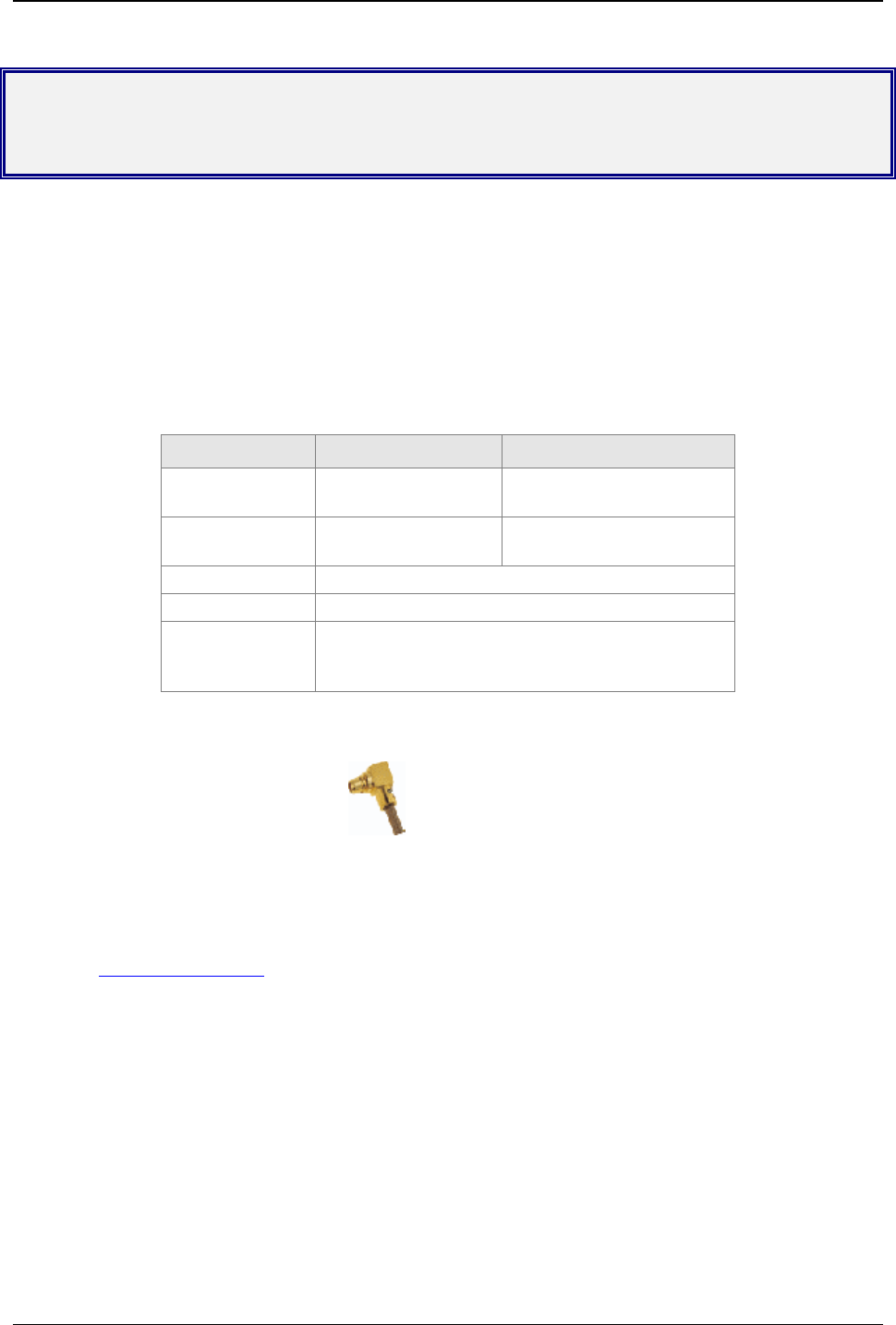
Appendix B – Sourcing Guide for Connectors/Peripherals
Wireless ModemModule MTMMC-C Developer's Guide 23
Appendix B – Sourcing Guide for Connectors and
Peripheral Devices
CDMA Antenna
The integrated modem antenna connector is a MMCX connector. The MMCX connector incorporates a 'Snap On'
latching action in order to make the connection easier with an excellent RF performance. An additional
advantage is its small physical size, which is 50% of the standard MCX connector.
This type of connector is suitable for the standard ranges of flexible and semi-rigid cables. The characteristic
impedance of the MMCX coaxial connector is 50 ohm. The antenna manufacturer must guarantee that the
antenna will be working according to the radio characteristics presented in the table below.
Radio Characteristics
CDMA 850 CDMA 1900
Frequency
RX
869 to 894 MHz 1930 to 1990 MHz
Frequency
TX
824 to 849 MHz 1850 to 1910 MHz
Impedance 50 ohms
VSWR <1.5
Typical
Radiated
Gain
0 dBi in at least one direction
MMCX Plug
The ModemModule requires an MMCX plug to connect to an antenna.
MMCX Connector Example (right angle type)
Antenna
An antenna with matting connector can be ordered, for example, from:
IMS Connectors Systems GMBH
http://www.imscs.com/
MMCX / SMA Adapter
A small MMCX / SMA adapter can be ordered, for example, from:
Amphenol
http://www.amphenol.com/
Order No: 908-31100
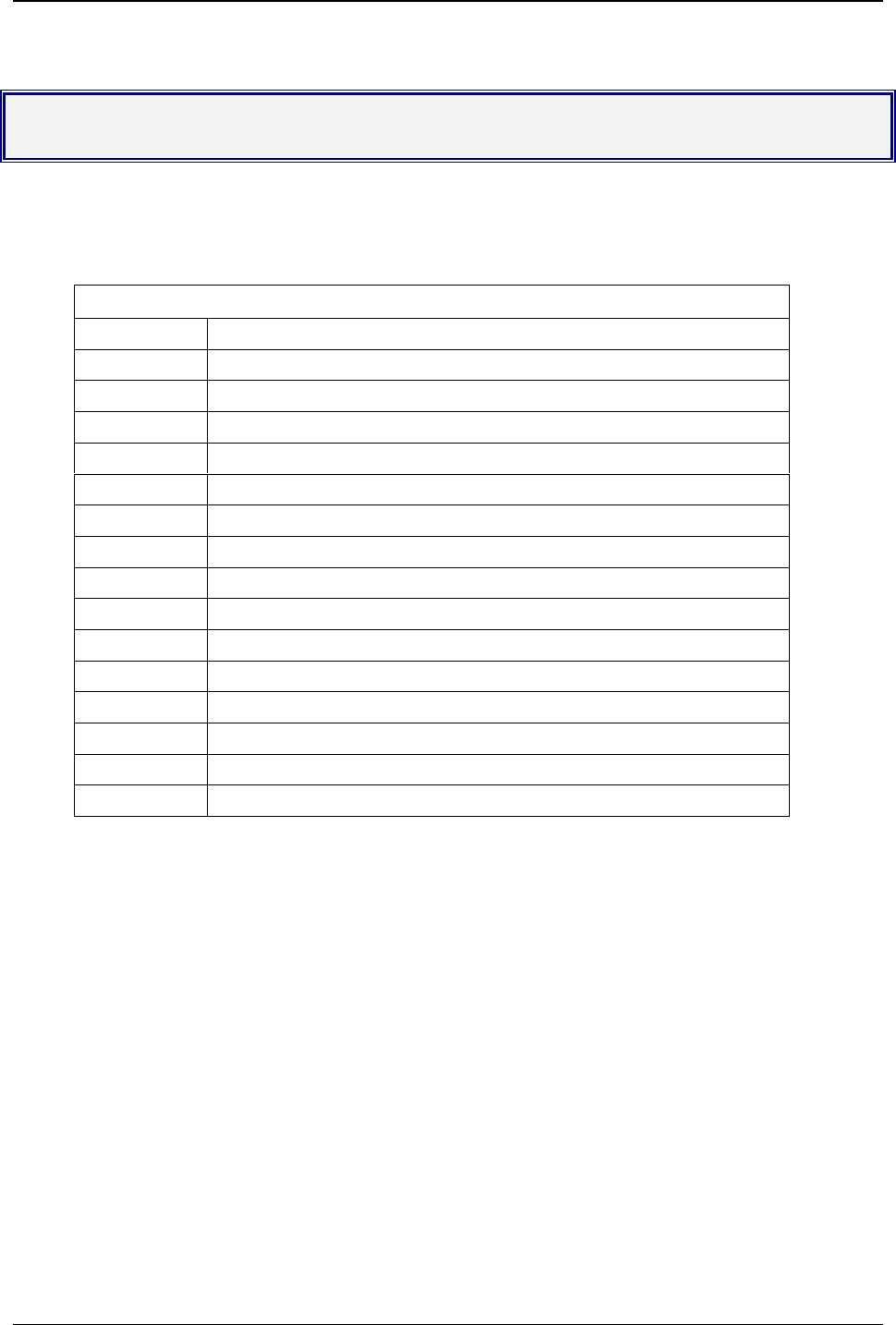
Appendix D – Acronyms and Abbreviations
Wireless ModemModule MTMMC-C Developer's Guide 24
Appendix C – AT Command List
For comprehensive information about AT Commands, please read the AT Command Manual.
AT Command List
General Commands
+CGMI Manufacturer Identification
+CGMM Request Model Identification
+CGMR Request Revision Identification
+CGSN Product Serial Number
+CSCS Select TE Character Set
+CIMI Request IMSI
+CCID Card Identification
+GCAP Capabilities List
A/ Repeat Last Command
+CPOF Power Off
+CFUN Set Phone Functionality
+CPAS Phone Activity Status
+CMEE Report Mobile Equipment Errors
+CKPD Keypad Control
+CCLK Clock management
+CALA Alarm management
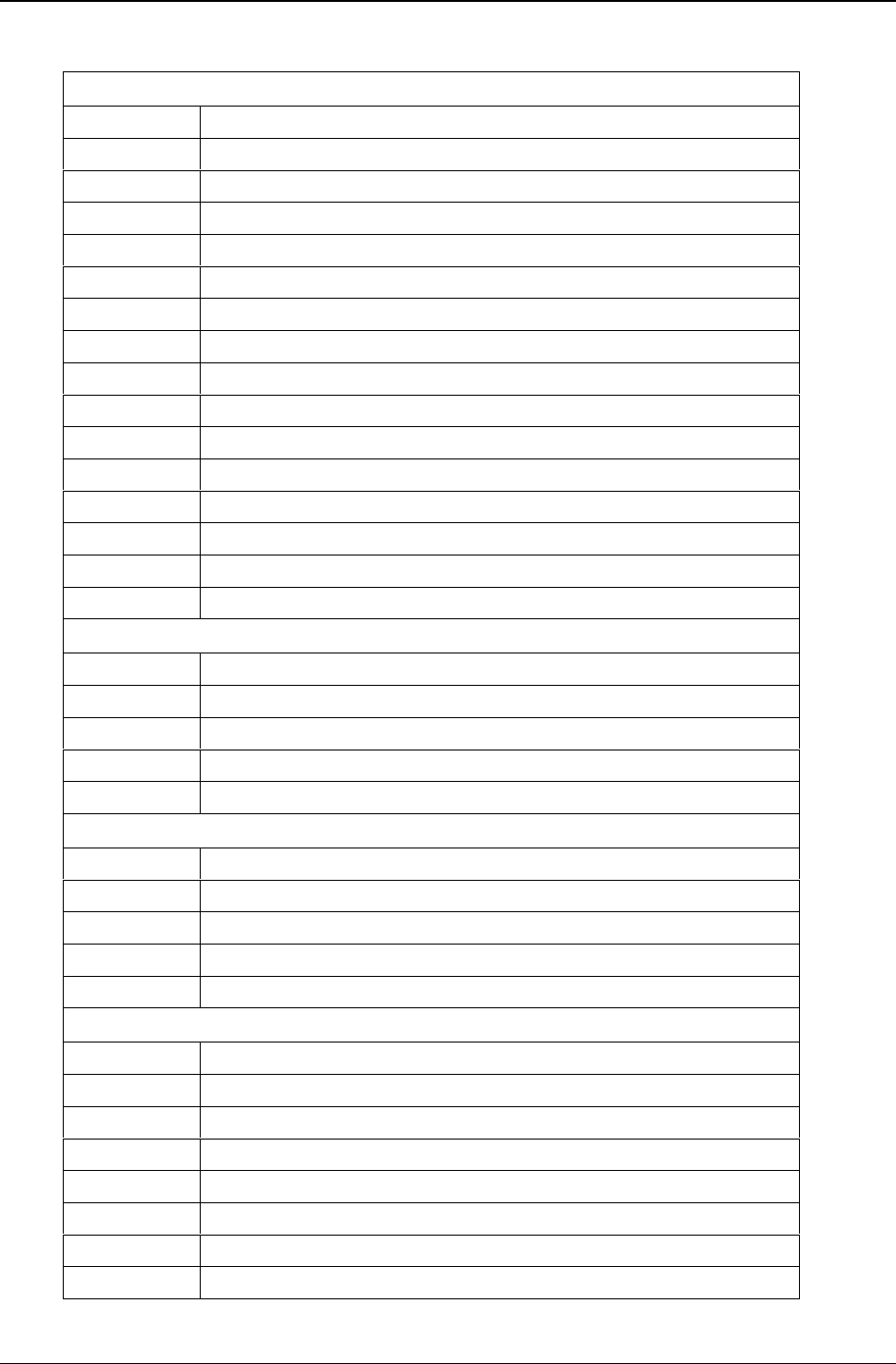
Appendix D – Acronyms and Abbreviations
Wireless ModemModule MTMMC-C Developer's Guide 25
AT Command List (cont’d)
Call Control Commands
DDial command
HHang-up Command
AAnswer a Call
+CEER Extended Error Report
+VTD, +VTS DTMF Signals
ATDL Redial Last Telephone Number
AT%Dn Automatic Dialing (or SMS send) with DTR
ATSO Automatic Answer
+CICB Incoming Call Bearer
+VGR, +VGT Gain Control
+CMUT Microphone Mute Control
+SPEAKER Speaker and Microphone Selection
+ECHO Echo Cancellation
+SIDET Side Tone Modification
+VIP Initialize Voice Parameters
+CSNS Single Numbering Scheme
Network Service Commands
+CSQ Signal Quality
+COPS Operator Selection
+CREG Network Registration
+WOPN Read Operator Name
+CPOL Preferred Operator List
Security Commands
+CPIN Enter PIN
+CPIN2 Enter PIN2
+CPINC PIN Remaining Attempt Number
+CLCK Facility Lock
+CPWD Change Password
Phone Book Commands
+CPBS Select Phone Book Memory Storage
+CPBR Read Phone Book Entries
+CPBF Find Phone Book Entries
+CPBW White Phone Book Entry
+CPBP Phone Book Phone Search
+CPBN Move Action in Phone Book
+CNUM Subscriber Number
+WAIP Avoid Phone Book Init
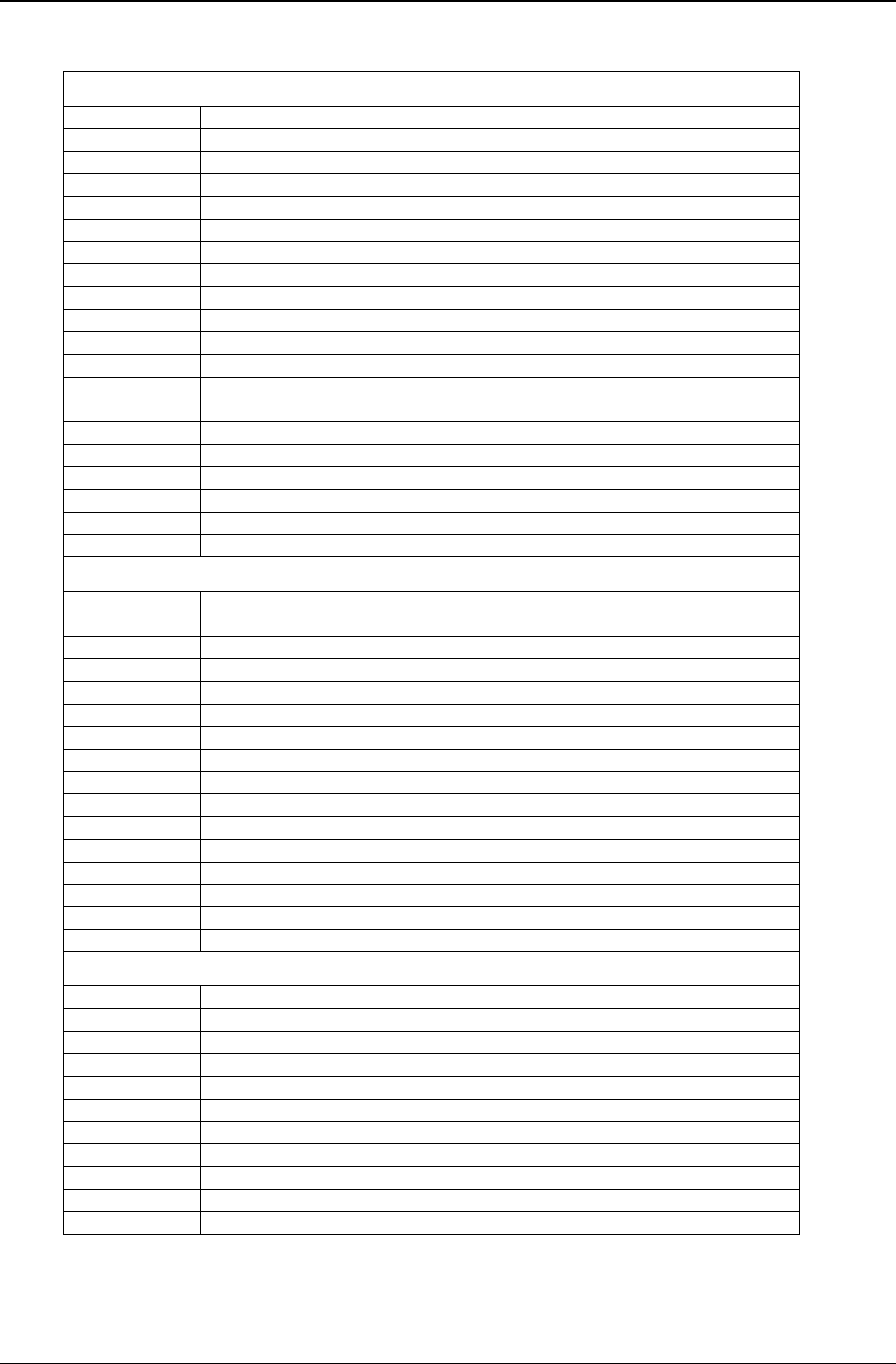
Appendix D – Acronyms and Abbreviations
Wireless ModemModule MTMMC-C Developer's Guide 26
AT Command List (cont’d)
Short Message Commands
+CSMS Select Message Service
+CNMA New Message Acknowledgement
+CPMS Preferred Message Storage
+CMGF Preferred Message Format
+CSAS Save Settings
+CRES Restore Settings
+CSDH Show Text Mode parameters
+CNMI New Message Indication
+CMGR Read Message
+CMGL List Message
+CMGS Send Message
+CMGW Write Message to Memory
+CMSS Send Message from Storage
+CSMP Set Text Mode Parameters
+CMGD Delete Message
+CSCA Service Center Address
+CSCB Select Cell Broadcast Message Types
+WCBM Cell Broadcast Message Identifiers
+WMSC Message Status Modification
+WMGO Message Overwriting
Supplementary Services Commands
+CCFC Call Forwarding
+CLCK Call Barring
+CPWD Modify SS Password
+CCWA Call Waiting
+CLIR Calling Line Identification Restriction
+CLIP Calling Line Identification Presentation
+COLP Connected Line Identification Presentation
+CAOC Advice Of Charge
+CACM Accumulated Call Meter
+CAMM Accumulated Call Meter Maximum
+CPUC Price Per Unit and Currency Table
+CHLD Call Related Supplementary Services
+CLCC List Current Calls
+CSSN Supplementary Service Notifications
+CUSD Unstructured Supplementary Service Data
+CCUG Closed User Group
Data Commands
+CBST Bearer Type Selection
+FCLASS Select Mode
+CR Service Reporting Control
+CRC Cellular Result Codes
+ILRR DTE-DCE Local Rate Reporting
+CRLP Radio Link Protocol Parameters
+DOPT Others Radio Link Parameters
%C Select Data Compression
+DS V42 bis Data Compression
+DR V42 bis Data Compression Report
\N Select Data Error Correcting Mode
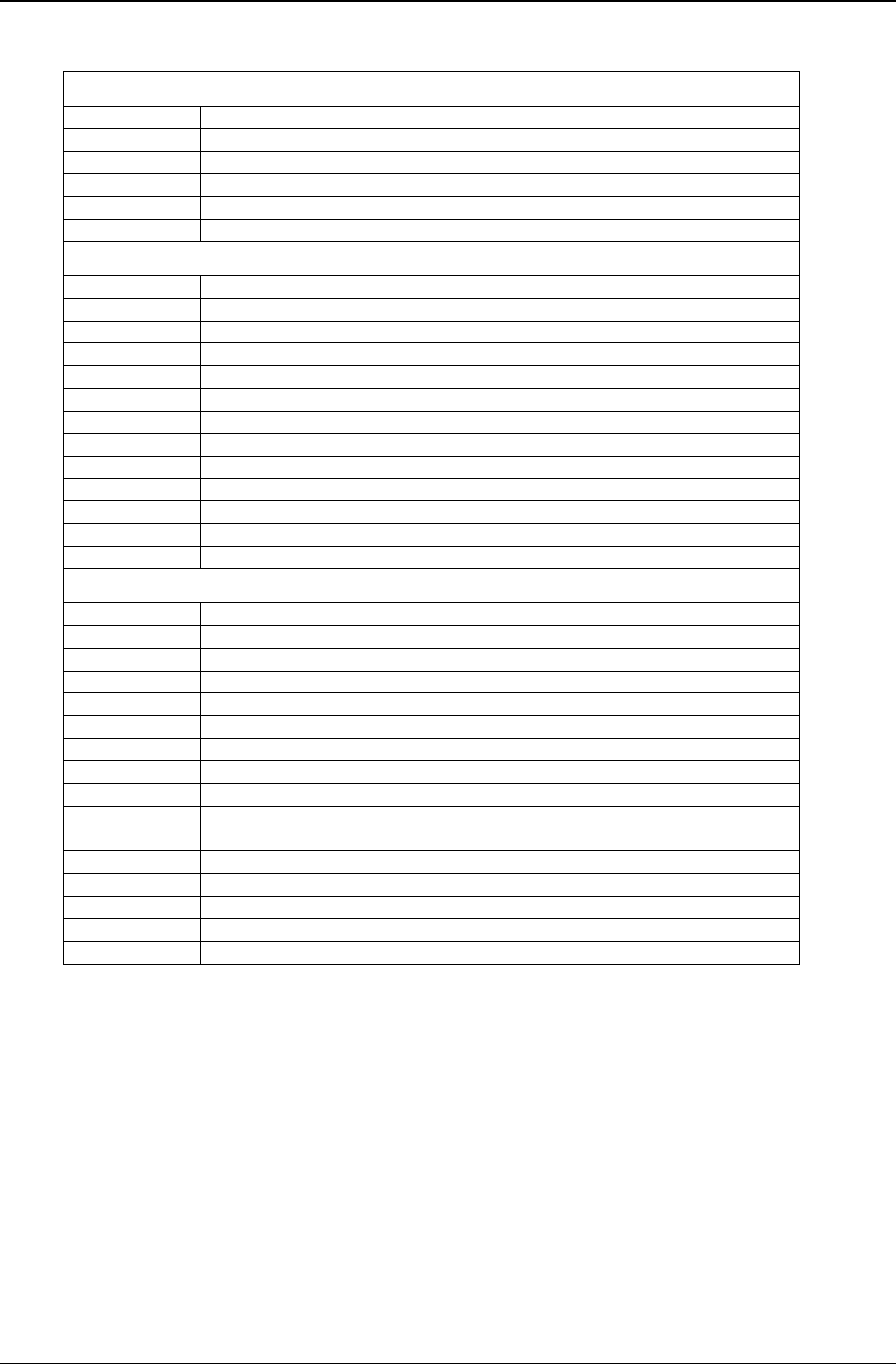
Appendix D – Acronyms and Abbreviations
Wireless ModemModule MTMMC-C Developer's Guide 27
AT Command List (cont’d)
Fax Commands
+FTM Transmit Speed
+FRM Receive Speed
+FTH HDLC Transmit Speed
+FRH HDLC Receive Speed
+FTS Stop Transmission and Wait
+FRS Receive Silence
Fax Class 2 Commands
+FDT Transmit Data
+FDR Receive Data
+FET Transmit Page Punctuation
+FPTS Page Transfer Status Parameters
+FK Terminate Session
+FBOR Page Transfer Bit Order
+FBUF Buffer Size Report
+FCQ Copy Quality Checking
+FCR Capability to Receive
+FDIS Current Sessions Parameters
+FDCC DCE Capabilities Parameters
+FLID Local ID String
+FPHCTO Page Transfer Timeout Parameter
V24 - V25 Commands
+IPR Fixed DTE Rate
+ICF DTE-DCE Character Framing
+IFC DTE-DCE Local Flow Control
&C Set DCD Signal
&D Set DTR Signal
&S Set DSR Signal
OBack to Online Mode
QResult Code Suppression
VDCE Response Format
ZDefault Configuration
&W Save Configuration
&T Auto-Tests
EEcho
&F Restore Factory Settings
&V Display Configuration
IRequest Identification Information
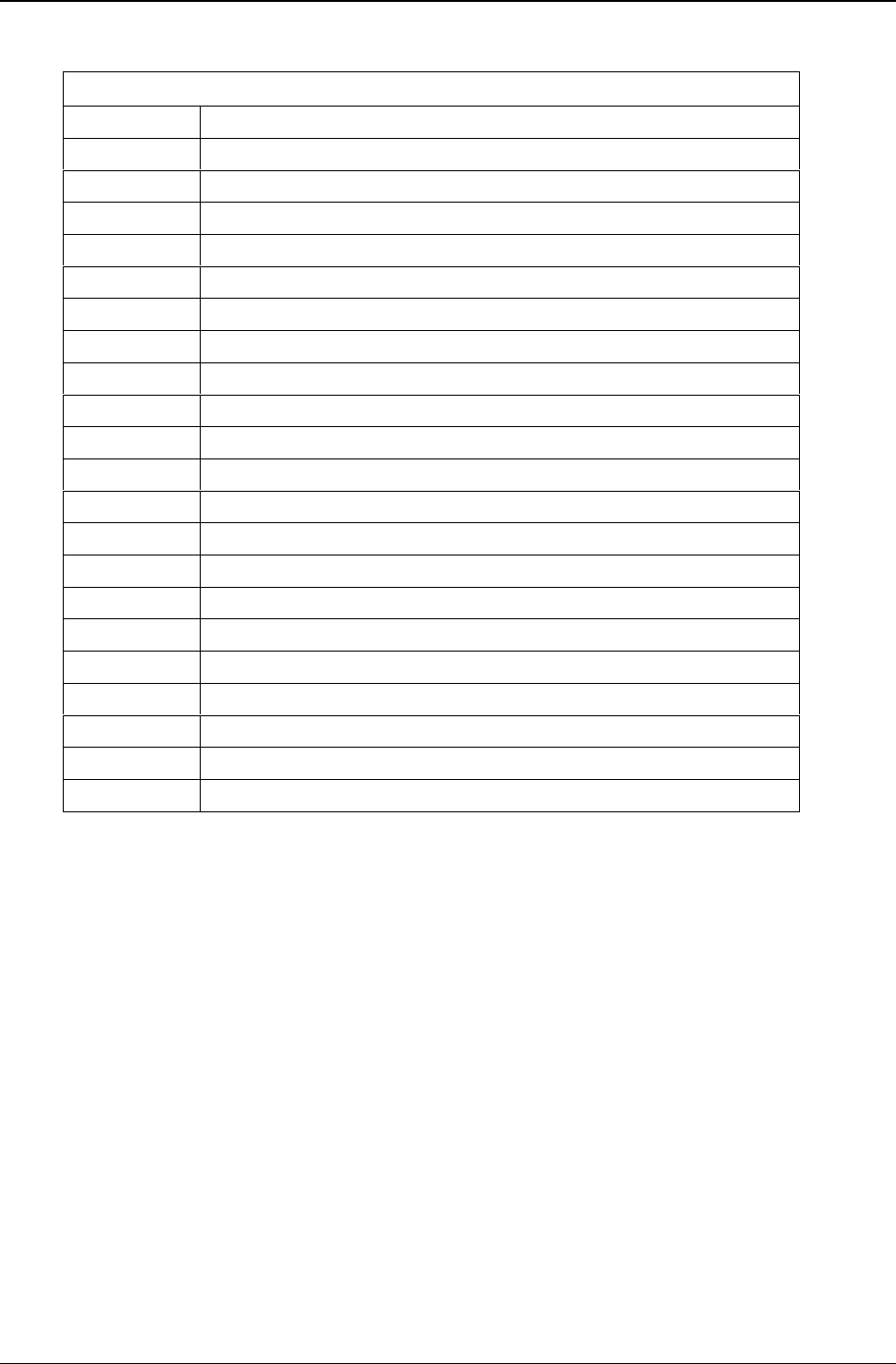
Appendix D – Acronyms and Abbreviations
Wireless ModemModule MTMMC-C Developer's Guide 28
AT Command List (cont’d)
Specific AT Commands
+CCED Cell Environment Description
+CCED Automatic RxLev Indication
+WIND General Indications
+ADC Analog Digital Converters Measurements
+CMER Mobile Equipment Event Reporting
+WLPR Read Language Preference
+WLPW Write Language Preference
+WIOR Read GPIO Value
+WIOW Write GPIO Value
+WAC Abort Command
+WTONE Play Tone
+WDTMF Play DTMF Tone
+WDWL Multi-Tech Downloading
+WVR Multi-Tech Voice Rate
+WDR Data Rate
+WHWV Hardware Version
+WDOP Date Of Production
+WSVG Multi-Tech Select Voice Gain
+WSTR Multi-Tech Status Request
+WSCAN Multi-Tech Scan
+WRIM Ring Indicator Mode
+W32K Power saving mode

Appendix D – Acronyms and Abbreviations
Wireless ModemModule MTMMC-C Developer's Guide 29
Appendix D – Acronyms and Abbreviations
ADC : Analog Digital Converter
ASIC : Application Specific Integrated Circuit
BCCH : Broadcast Control Channel
CE : Communauté Européenne
CLK : Clock
CTS : Clear To send
dB : decibel
DCD : Data Carrier Detect
DCE : Data Circuit Terminating Equipment
DSR : Data Set Ready
DTE : Data Terminal Equipment
DTR : Data Terminated Ready
EFR : Enhanced Full Rate
EMC : Electromagnetic Conformity
EN : Enable
ETSI : European Telecommunications Standards Institute
FAC : Final Assembly Code
FR : Full-Rate
FTA : Full Type Approval
GND : Ground
GPIO : General Purpose Input Output
HR : Half-Rate
MO : Mobile Originated
MT : Mobile Terminated
OEM : Original Equipment Manufacturer
PDA : Personal Digital Assistant
PCB : Printed Circuit Board
PRES : Presence
RI : Ring Indicator
RTS : Request To Send
SIM : Subscriber Identity Module
SMD : Surface Mounted Design
SMS : Short Message Service
TAC : Type Approval Code
TDMA : Time Code Multiple Access
TE : Terminal Equipment
VSWR : Voltage Standing Wave Ratio
WAP : Wireless Application Protoc

Index
Wireless ModemModule MTMMC-C Developer’s Guide 30
Index
1X ..................................................................9, 10, 11
2X ..................................................................9, 10, 11
3X ......................................................................10, 11
Advice Of Charge....................................................25
analog ................................................................17, 28
antenna...................................................17, 19, 20, 21
antenna cable ...........................................................17
AUXV0......................................................................9
BOOT ........................................................................9
Call Barring .............................................................25
Call Forwarding.......................................................25
Call Waiting.............................................................25
CDMA antenna........................................................22
CDMA Compliance.................................................21
CE......................................................................21, 28
Cell Broadcast .........................................................25
Class 10 .....................................................................6
Closed User Group ..................................................25
CMOS..................................................................9, 11
column .....................................................................10
connector .............................................................9, 10
data ..............................................................5, 6, 9, 18
Data Carrier Detect..................................................28
dB ............................................................................28
digital.......................................................................17
EFR..........................................................................28
Electrical Characteristics ...........................................9
EMC protection .......................................................17
ESD protection ........................................................17
ETSI.........................................................................28
fax..............................................................................5
FR ............................................................................28
gain ..........................................................................21
general purpose....................................................9, 10
GND ........................................................9, 10, 18, 28
GPIO..................................................................27, 28
GPRS .........................................................................1
ground plane ............................................................17
CDMA .....................................................6, 17, 19, 21
hardware ..............................................................6, 18
HR ...........................................................................28
I/O..................................................................9, 10, 11
interface .....................................................6, 9, 10, 17
MIC1N.......................................................................9
MIC1P .......................................................................9
MIC2N.......................................................................9
MIC2P .......................................................................9
MMCX (Miniature Micro Connector) .....................22
MO.....................................................................21, 28
modem .........................................................19, 20, 21
module .......................................................................9
MT ...........................................................................28
OFF................................................................9, 18, 20
ON/~OFF...................................................................9
operating conditions ................................................21
PCB .........................................................................28
PCS..........................................................................21
power .......................................................9, 17, 19, 21
Power Consumption ................................................12
radio.............................................................19, 20, 21
Radio Characteristics...............................................22
RF ......................................................9, 17, 19, 20, 21
RST............................................................................9
serial link ...........................................................17, 18
signal........................................................................13
SIM....................................................................10, 28
SIMCLK ..................................................................10
SIMDATA...............................................................10
SIMPRES ................................................................10
SIMRST...................................................................10
SIMVCC..................................................................10
SMS ...................................................................24, 28
socket.......................................................................10
speaker.....................................................................17
SPI ...........................................................................10
SPK1N.......................................................................9
SPK1P .......................................................................9
terminal........................................................17, 18, 21
Vcc.............................................................................9
WAP ........................................................................28